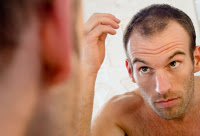Description
Construction of the root and strand.
is a filamentous biomaterial, that grows from follicles found in the dermis. The human body, apart from its glabrous skin, is covered in follicles which produce thick terminal and fine vellus hair. Most common interest in hair is focused on hair growth, hair types and hair care, but hair is also an important biomaterial primarily composed of protein, notably keratin.
Hair growth begins inside the hair follicle. The only "living" portion of the hair is found in the follicle. The hair that is visible is the hair shaft, which exhibits no biochemical activity and is considered "dead".The base of the root is called the bulb, which contains the cells that produce the hair shaft.Other structures of the hair follicle include the oil producing sebaceous gland which lubricates the hair and the erector pili muscles, which are responsible for causing hairs to stand-up. In humans, with little body hair, the effect results in goose bumps.
Each strand of hair is made up of the
medulla,
cortex, and
cuticle.The innermost region, the medulla, is not always present and is an open, unstructured region. The highly structured and organized cortex, or middle layer of the hair, is the primary source of mechanical strength and water uptake. The cortex contains
melanin, which colors the fiber based on the number, distribution and types of melanin granules. The shape of the follicle determines the shape of the cortex, and the shape of the fiber is related to how straight or curly the hair is.
Hair pigment
All natural hair colors are the result of two types of hair pigment. Both of these pigments are melanin types, produced inside the hair follicle and packed into granules found in the fibers. Eumelanin is the dominant pigment in dark-blond, brown, and black hair, while pheomelanin is dominant in red hair. Blond hair is the result of having little pigmentation in the hair strand. Gray hair occurs when melanin decreases or disappears
Human hair growth
Hair grows everywhere on the external body except for mucus membranes and glabrous skin, such as that found on the soles of the hands, feet, and lips.
Hair follows a specific growth cycle with three distinct and concurrent phases: anagen, catagen, and telogen phases. Each phase has specific characteristics that determine the length of the hair. All three phases occur simultaneously; one strand of hair may be in the anagen phase, while another is in the telogen phase.
The body has different types of hair, including vellus hair and androgenic hair, each with its own type of cellular construction. The different construction gives the hair unique characteristics, serving specific purposes, mainly warmth and protect.
Eyebrows and eyelashes.
The eyebrows are situated above the eyelids on the forehead. In many other mammals they contain much longer hairs that are upright, functioning as tactile sensors. While they have little significance to the survival of humans, they remain a part of the body's physiological makeup because of the role they play in protecting the eyes from dirt, sweat, and rain, as well as non-verbal communication.
Straight hair
According to the recent single origin hypothesis, anatomically modern humans arose in East Africa approximately 200,000 years ago (Tishkoff, 1996). Then, ~150,000 years later, modern humans began to expand their range to regions outside of (and within) this continent (Tishkoff, 1996). The skin of those in the group that left the African continent had developed the ability to manufacture vitamin D (which was essential for bone development) upon exposure to UV light.However, the UV light of northern regions was too weak to penetrate the highly pigmented skin of the initial migrants in order to provide enough vitamin D for healthy bone developmen.
In this sense, the evidence with regard to the evolution of straight hair texture seems to support Jablonski's suggestions
[28] that the need for vitamin D triggered the transition back from dark to light skin.
This argument is made based on the principle that straight fibers better facilitate the passage of UV light into the body relative to curly hair. It is substantiated by Iyengar's (1998) findings that UV light can pass through straight human hair roots in a manner similar to the way that light passes through fiber optic tubes (Iyengar, 1998).Nonetheless, some argue against this stance because straighter hair ends tend to point downward while fiber optics requires that light be transmitted at a high angle to the normal of the inner reflective surface. In light of this, they suggest that only light reflected from the ground could successfully enter the hair follicle and be transmitted down the shaft
 Minoxidil (Rogaine) is available over the counter and available in 2%, 4%, and 5% concentrations. It is marketed for women at the 2% concentration but may be used in higher strengths as directed by your doctor.
Minoxidil (Rogaine) is available over the counter and available in 2%, 4%, and 5% concentrations. It is marketed for women at the 2% concentration but may be used in higher strengths as directed by your doctor.











